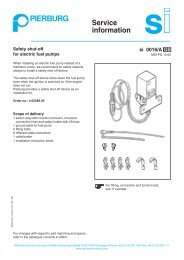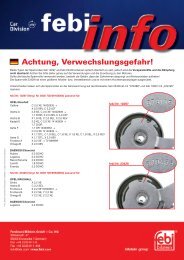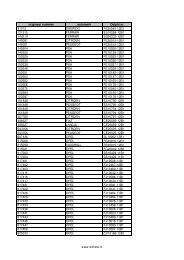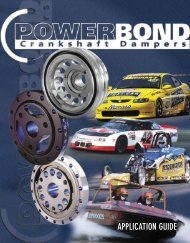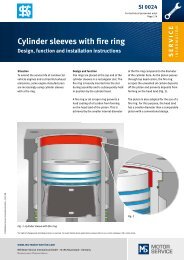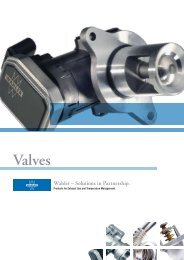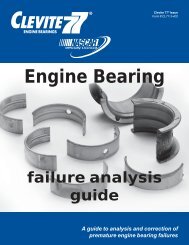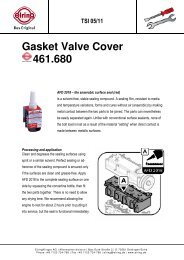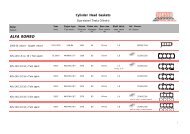EvEry bEaring you nEEd
EvEry bEaring you nEEd
EvEry bEaring you nEEd
You also want an ePaper? Increase the reach of your titles
YUMPU automatically turns print PDFs into web optimized ePapers that Google loves.
[1]<br />
[2]<br />
Fundamentals<br />
[ fig.1] engine elements connected<br />
with the bearings<br />
[1] main bearing cap<br />
[2] main cap bearing bolts<br />
[3] main bearings<br />
[4] con rod bearing crank pin<br />
[5] main bearing crank pin<br />
[6] crankshaft<br />
[7] engine block<br />
[8] cylinder bores<br />
[3]<br />
[7]<br />
[4]<br />
[5]<br />
[6]<br />
[1]<br />
Installation of bearings<br />
In an internal combustion engine there are certain sites<br />
where components move against each other. At these<br />
sites friction can lead to wear and damage of the components<br />
involved. To avoid these effects bearings are<br />
employed.<br />
A bearing has the job of transmitting power, of reducing<br />
friction and of preventing wear on expensive engine<br />
parts. On top of this, bearings should be both economical<br />
and quick and easy to replace in case of damage.<br />
Types of bearings<br />
In an engine, the most important bearing sites are found<br />
at the crankshaft and camshaft.<br />
The crankshaft is held in the crankcase by the main<br />
bearings (Figure 1). At one end, the connecting rods are<br />
linked by bearings of the crankshaft. At the other end<br />
the connecting rods are linked by the connecting rod<br />
bush to the piston pins (Figure 2). The crankshaft is held<br />
in either the crankcase or the cylinder head by camshaft<br />
half bearings or camshaft bushes.<br />
Engineers distinguish between different kinds of bearings<br />
in various ways. On one hand, we can divide them up, on<br />
the basis of the nature of the power transmitted. In this<br />
case, we distinguish between radial and axial bearings.<br />
On the other hand, we may distinguish on their design.<br />
Then we distinguish between anti-friction bearings (e.g.<br />
ball or roller bearings) and sliding bearings.<br />
In four stroke engines, predominantly sliding bearings<br />
are used as radial bearings. Radial bearings are produced<br />
either in form of divisible half shells or as bushes.<br />
The axial bedding of the crankshaft and the camshaft is<br />
done by trust washers or flanged bearings.<br />
Strengths & weaknesses<br />
of engine bearings<br />
For internal combustion engines, sliding engine bearings<br />
offer a number of advantages over anti-friction<br />
bearings. One principle advantage of sliding bearings<br />
is that it can be divided in half shells. For this reason,<br />
a sliding bearing can, in contrast to a roller bearing,<br />
be mounted on a crankshaft.<br />
Sliding bearings of the same dimensions as anti-friction<br />
bearings can bear higher loads. Additionally, they are<br />
less sensitive to shock loads. As a consequence, sliding<br />
bearings have a longer lifetime and they generate less<br />
noise.<br />
In comparison to roller bearings, sliding bearings have a<br />
smaller volume and less mass. Therefore, their production<br />
is more economical.<br />
A disadvantage of sliding engine bearings is that they<br />
produce greater friction than anti-friction bearings at<br />
low revs. This drawback is most significant when starting<br />
up an engine, when sliding engine bearings cause<br />
both boundary friction and mixed friction, leading to<br />
greater wear to components than they suffer when the<br />
engine is running.<br />
[ fig.2] elements of a connecting rod<br />
[1] connecting rod<br />
[2] con rod bolt<br />
[3] con rod cap<br />
[4] con rod bearings<br />
[2]<br />
[3]<br />
[8]<br />
[1]<br />
[4]<br />
8 Bearings Technical Manual<br />
9




